


CNC Router
Educational Success Stories
 Affordable Precision Educational CNC Router Affordable Precision Educational CNC RoutereMail us at technosales@technocnc.com |
William
Baltazar is a Technoogy Education teacher at Dr Michael M Krop
High School, Miami FL. David Millson is editorial consultant for
CNC Software/Mastercam - Appeared in Tech Directions, January,
1999"It's a Classroom Gas!"Step-by-step creation of competitive CO2 cars reinforces students' self-image and performance.By William Baltazar and David Milison
Baltazar has taught the combined CAD/CAM/CNC classroom activity unit for six years, first in Florida middle schools, then at Miami Senior High School, and now at the new Dr. Michael M. Krop High School in Miami Beach. The project became feasible with the synergistic combination of school-owned Mastercam CAD/CAM software and Techno's DaVinci CNC machine, complete with special CO2 car fixtures and cumculum software licensed from IMS Technologies. These different softwares integrate seamlessly, providing starting-point templates for first-time machinists, and the template parameters conform to the ISA official CO2 car competition specifications.
Earlier attempts at using CAD/CAM to give all students an even start were also counterproductive to the goal of increasing student motivation CAD systems had been able to describe complex 3D shapes but required too much training to get students up to speed sufficient to draw the car. Feed rates in the 10-15 IPM range could take as long as two and a half hours to rough out each car. Even the advent of automated toolpath creation never afforded enough time to cycle an entire class through the machining process without lagging or overlapping subsequent curriculum elements. Setting young minds free. "But," says Jim Kayle, Curriculum Specialist for Technology Education for Broward County in Florida, "I was convinced, even then, that a design-based curriculum was the direction we should be going in. If the learning process is enhanced by using an advanced technological application, that,s terrific." Kayle's district, the fifth largest in the nation, began purchasing the Techno CO2 system soon after its development. "A program like the car," he says "allows kids to succeed in a very complex field. CNC isn't simple, so this is an opportunity for them to gain relevant experience in a very technical area. The 300,000+ student Miami-Dade school district-the country's third largest-includes William Baltazar''s school. Miami Dade County's students have won numerous awards in TSA competitions at the regioinal, state and nationals levels, and continue to be excited about using the mill. Kayle's counterpan in the Miami-Dade school district, Clare Warren, says that her teachers are also excited about the mill and continually explore new applications. "We consistently conduct training sessions to keep our faculty up to speed," she says, and will even offer a graduate-level course for her teachers through a local university next semester. She will also send an instructor to Mastercam's educational headquarters in Gig Harbor, WA, to train in Mastercam Level II so that he, along with William Baltazar, can serve as a resource for teachers throughout the county. Step-by-step through the process... Baltazar found some colleagues at teacher workshops daunted by a perceived complexity of the CO2 unit. He recalls having one of his students, Carlos Vasquez, design a car before their very eyes at a workshop in conjunction with the TSA national convention in Louisville in 1995. The bottom line: anyone can do it. Here's how it works. PC-based Mastercam already embodies the processes a student would need to design a 3D shape. The resident CO2 car template file puts students through a 10-day self-teaching matrix during which they walk through the steps from initial geometry to toolpathing. The program allows them to make cross-section-based design modifications of their own before creating the NC toolpath and machining their invention.
The template file gives students an isometric overview of the inch-by-inch cross sections of the left half of an already-designed 12"-long car. They can access single cross-sectional slices through the CO2 car blank every inch by turning off all levels and turning back on just the slice of car they warn to describe. The template shows where to start and stop the spline, which describes the car body, and which sections to avoid when cutting. To alter the shape, students simply chart new points on the template section with the mouse. The software then creates a spline through these points. The students then change level and depth, blank the old template, and make the new one visable. They move easily, step by step, through the process and, with imagination, can describe a complex car body worthy of Ferrari. After all the cross-sections are drawn, the halves are then mirrored to complete the design, the splines surfaced and then rendered. The rendered image allows students to examine their designs for TSA compliance and can be sent to a printer. Seeing the real thing on the screen assures students of having successfully transformed their own aesthetic concepts into a working file. The design is then rotated to assume the same position as the CO2 car blank that will be mounted in the fixture. Next, students put a window around the cross-section again, and the toolpath for the right side of the car is automatically generated. Students then use the solid model toolpath verification to ensure a gouge-free machining performance. The IMS fixture is set up to cut the cars from the side-first the right, then the left-to eliminate any possible tool burial problems of the 1" deep cutter in the 2-1/2" stock. A properly set up fixture with positive stop indexing makes for a virtually seamless two-pass finished product.
... and beyond. For advanced high school and secondary students, designing CO2 cars can be very challenging. They can go beyond defining their cars with simple cross-sectional slices and take advantage of the software's full surface modeling. The fixture can also index the car into position so that those students who envision alternative designs have the machining means to bring them to life. All four sides can incorporate finer detail and different shapes. One student, motivated to experiment with the CAD possibilities, designed a shell car, basically a hollowed-out version of the template car. He found that the empty cavity was catching air and slowing the car. Undaunted he countered the flaw by modifying the design to include vents to allow the air to pass through. With re-engineering time allowed by the DaVinci's machine's speed, he succeeded on the third attempt, the vents finally worked as he had hoped.
An optional special fixture attachment makes wheels that are much truer than hobby shop parts and that can vary in weight to bring the cars to the exact minimum weight specification. The system's flexibility allows students to experiment even further, designing planes, airfoils, boats and rockets, for example. The DaVinci machine has ball screws on all three axes, just like industrial machines, improving its power and accuracy. Its 24000 RPM spindle allows an 80 IPM feed rate, turning out each side of the car in 8-10 minutes, while beautifully machining the wood. At that speed, an entire class can cycle through the car curriculum in a workable time frame. Training winners. Baltazar takes his whole class through the complete process in nine weeks. He begins with a three-day demonstration, then turns the students loose on the technology. Excitement over the project is so high that students often come after the school class day to fine-tune their cars, as do TSA members who are not taking the course but want to enter cars in competition. It's no secret that the ability to give the end product a personalized, concept-car look helps make the program attractive. What's more, the showing at such regional and state events as the Dade County Youth Fair. CO2 car race reflects positively on the schools represented. Baltazar is no stranger to pride in his students' ability to win. His first students to compete in the national TSA event hailed from Thomas Jefferson Middle School in Miami. After coming in first through 14th out of the 16 front runners at the Youth Fair in 1996, they placed first and second in the state and national races. In 1997, his students from Miami Beach Senior High School placed second in the state. They were bracketed in first and third places by Miami students at Barbara Coleman Senior High School. An amazing race. "Winning a race certainly isn't everything," says Baltazar. He recalls another kind of victory for a student with whom he worked for two years. "He was hyper-just not able to concentrate." He might have been labeled as an ADD student. He developed an interest in the CO2 car competition and came regularly to after-school sessions to learn the system. His Youth Fair entry didn't place, but he had, by then, developed an abiding interest in technology. "He's finishing his second year at Miami-Dade Community College," Baltazar almost gleefully reports, "and is planning to follow that with another two years' work on an engineering degree. The step-by-step entry into CAD/CAM/CNC resulted in a tremendously positive change in this student's life." Baltazar suggests that the CO2 exercise probably has similar but less dramatic effects on many other students. Multiplied by the more than 50 schools in south Florida now using the same curriculum, then by the 234 nationwide, and it's clear that those little wooden cars have provided technology education students with a lot of good mileage toward adult employability and success. William Baltazar is a Technology Educa non teacher at Dr Michael M Krop High School, Miami, FL David Millson is editorial consultant for CNC Software/MasterCam Tech Directions - January 1999 MANUFACTURING
Here's the KEY to getting your students excited about CNC! With the Techno CO2 car curriculum, your students spend time learning technology instead of carving and sanding. With MasterCAM Mill level 1 software, your students learn an industrial strength program with easy to follow step-by-step instructions.
|
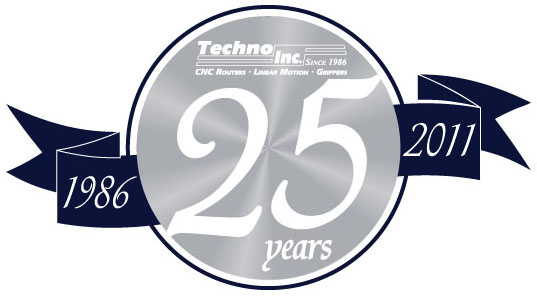 Techno is celebrating over 25 years of CNC technology
expertise. Our Educational sector provides industrial quality products
at educational prices with a network of award-winning Educators. We can
provide CNC Curriculums, CNC Projects, Technical Information and
Packages for any educational classroom.
Techno is celebrating over 25 years of CNC technology
expertise. Our Educational sector provides industrial quality products
at educational prices with a network of award-winning Educators. We can
provide CNC Curriculums, CNC Projects, Technical Information and
Packages for any educational classroom.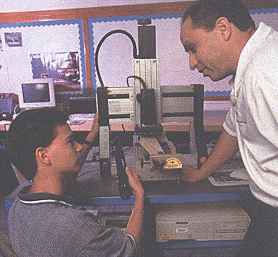
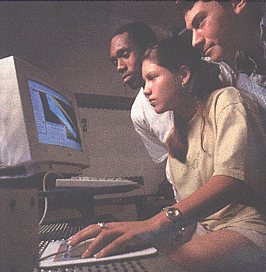 Leveling the playing field. For years, students
had entered local, state, regional, and national Metric 500 CO2
propelled car competitions intended to provide positive early
exposure to technology for middle and high school students.
Since the cars were hand-carved, success depended so much on age,
manual dexterity, and previous experience that earlier outcomes
acted more often to test woodworking skills than design
performance. Frustration, especially at the middle school level,
was a frequent, unintended consequence
Leveling the playing field. For years, students
had entered local, state, regional, and national Metric 500 CO2
propelled car competitions intended to provide positive early
exposure to technology for middle and high school students.
Since the cars were hand-carved, success depended so much on age,
manual dexterity, and previous experience that earlier outcomes
acted more often to test woodworking skills than design
performance. Frustration, especially at the middle school level,
was a frequent, unintended consequence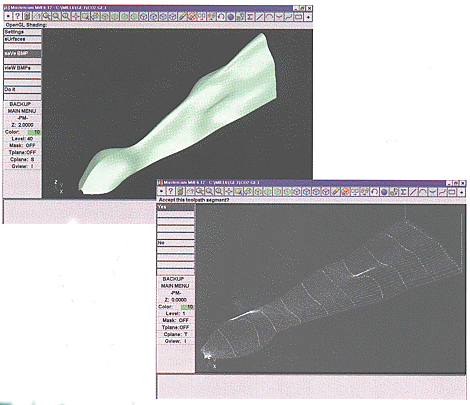
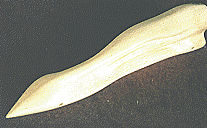 When the stock is mounted, the shaft on
the back of the fixture engages the pre-drilled CO2 canister
hole in the blank and is pushed forward until the front of the
blank fits into a holder at the front of the fixture A few taps of
a softblow hammer secures the blank for right-side cutting.
After the right side is cut, the fixture is unlocked and indexed
180º to cut the left side.
When the stock is mounted, the shaft on
the back of the fixture engages the pre-drilled CO2 canister
hole in the blank and is pushed forward until the front of the
blank fits into a holder at the front of the fixture A few taps of
a softblow hammer secures the blank for right-side cutting.
After the right side is cut, the fixture is unlocked and indexed
180º to cut the left side. In another
creative burst, the student designed a flexible suspension that he
hoped would absorb the shock from bumps, reducing bounce and
increasing speed Unfortunately, the original suspension was so
soft that the rear of the car rubbed the surface The redesigned,
stiffer suspension produced a workable combination of flexibility
and stiffness-again the advantage of CAD/CAM speed and rapid
machining turnaround.
In another
creative burst, the student designed a flexible suspension that he
hoped would absorb the shock from bumps, reducing bounce and
increasing speed Unfortunately, the original suspension was so
soft that the rear of the car rubbed the surface The redesigned,
stiffer suspension produced a workable combination of flexibility
and stiffness-again the advantage of CAD/CAM speed and rapid
machining turnaround.